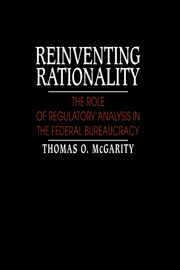Book contents
- Frontmatter
- Contents
- Acknowledgments
- Abbreviations
- Introduction
- Part I The clash of regulatory cultures
- Part II Regulatory analysis in theory and practice
- Part III Structuring regulatory analysis into the decisionmaking process
- 11 Roles for the regulatory analyst
- 12 The hierarchical model
- 13 The outside advisor model
- 14 The team model
- 15 The adversarial model
- 16 A hybrid model
- 17 Selecting the right model
- Part IV Review of regulatory analysis
- Part V Conclusions
- Notes
- Bibliography
- Index
12 - The hierarchical model
Published online by Cambridge University Press: 16 October 2009
- Frontmatter
- Contents
- Acknowledgments
- Abbreviations
- Introduction
- Part I The clash of regulatory cultures
- Part II Regulatory analysis in theory and practice
- Part III Structuring regulatory analysis into the decisionmaking process
- 11 Roles for the regulatory analyst
- 12 The hierarchical model
- 13 The outside advisor model
- 14 The team model
- 15 The adversarial model
- 16 A hybrid model
- 17 Selecting the right model
- Part IV Review of regulatory analysis
- Part V Conclusions
- Notes
- Bibliography
- Index
Summary
Many agencies did not modify existing institutional arrangements to meet the analytical requirements of the Executive Orders and the Regulatory Flexibility Act (RFA). Several simply added the task of preparing regulatory analysis documents to the responsibilities of the technical staff without creating a separate regulatory analysis office. The same employees who draft the rulemaking documents also draft the regulatory analysis documents. The regulatory analysis then winds its way up through the hierarchy of the program office along with the other rulemaking documents. Under this “hierarchical model” the technical staffers and their superiors at each level in the agency hierarchy can become aware of the relevant information and analysis, but there is no separate institutional entity to skeptically review rulemaking documents and otherwise carry the flag for comprehensive analytical rationality.
Both of the agencies chosen here as examples of the hierarchical model are lodged in the United States Department of Agriculture (USDA). USDA is so decentralized that in the words of one USDA employee, it is “like a supermarket.” As a practical matter, the individual services within USDA are relatively autonomous. All documents that are published in the Federal Register, however, must receive clearance for legal sufficiency from the centralized Office of the General Counsel. USDA has a large staff of agricultural economists in the Economic Research Service, who assemble data relevant to the agricultural economy and make projections about future crop yields, prices, and exports. Although the Service plays a fairly small role in preparing regulatory analyses, informal discussions between its economists and regulatory analysts in the agencies occur frequently.
Information
- Type
- Chapter
- Information
- Reinventing RationalityThe Role of Regulatory Analysis in the Federal Bureaucracy, pp. 191 - 199Publisher: Cambridge University PressPrint publication year: 1991
Accessibility standard: Unknown
- 1
- Cited by
